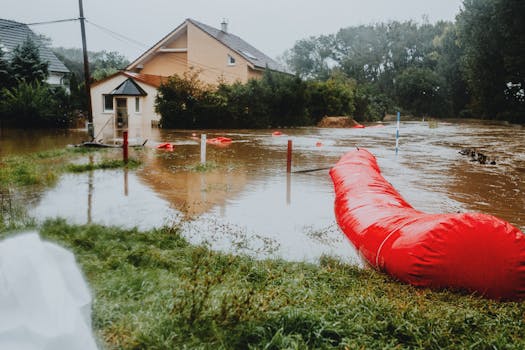Home Insurance
The Role of Location in Home Insurance Costs: What US Homeowners Need to Know
Your home's location plays a huge role in what you pay for insurance. Learn the key home insurance location factors shaping premiums so you can make smart moves and keep your home covered.
Advertisement
The Role of Location in Home Insurance Costs: What US Homeowners Need to Know
Think of house shopping: price tags swing wildly even in neighboring neighborhoods. The same is true for home insurance. Home insurance location factors shape how much protection will ultimately cost.
Insurance rates are far from random. They reflect complex risk maps that tie closely to where your house stands. This makes your ZIP code, proximity to coastlines, and local fire services powerful predictors when estimating annual premiums.
Let’s explore how home insurance location factors matter in every policy quote. We’ll break down which risks rise and fall by address, how carriers measure them, and what smart shoppers say when comparing options.
Proximity, Region, and Risk: Pinpointing Your Insurance Price
Every insurer checks the location first. You’ll see pricing shift immediately once you enter a street address. Local stats—crime, climate, distance to help—impact your home insurance location factors more than house features.
Beneath the surface, underwriters layer public safety scores, historical storm data, and neighborhood claim patterns to predict risks. Living blocks apart can nudge premiums higher or lower when even subtle differences add up.
Distance to Fire Services: Living Near Support Means Savings
Insurers shave dollars off your premium if you live within five miles of a fire station. People in remote stretches notice higher prices, since response times matter for home insurance location factors.
A homeowner might say, “I wanted the quiet outskirts, but my agent warned this added $250 yearly because emergency crews would need twenty minutes to arrive.” That single detail becomes a bargaining chip during quoting.
If you’re selecting property, ask, “How quickly can help arrive here?” Jot down these times to compare different listings with your agent before committing.
Coastal Area Risks: Flood and Wind Shape Costs Dramatically
Properties within a certain range of the ocean see steeper insurance bills thanks to flood and wind risk—vital home insurance location factors. Policies usually exclude flood damage unless you add specific flood coverage.
When reviewing listings near the beach or major rivers, remember: “My insurance agent added windstorm coverage that cost double the inland rate due to local hurricane history.” Those costs stack up quickly in storm-prone states.
If a property’s elevation is low, or it sits near a waterway, budget for higher base rates and mandated add-ons. Always read floodplain reports before finalizing a purchase.
| Location Factor | Example Scenario | Expected Premium Impact | Action Item |
|---|---|---|---|
| Within 1 mile of a fire station | Suburban block, quick emergency access | Lower | Ask your agent for distance-based discounts |
| Coastal neighborhood | Cities near the Gulf or Atlantic | Higher | Request windstorm and flood policy quotes |
| Urban area with higher crime rates | Downtown, mixed-income zip code | Moderate to higher | Consult for theft/vandalism coverage add-ons |
| Mountain or forest community | Remote, wildfire-prone locations | Higher | Get wildfire protection endorsements |
| Newly developed neighborhood with hydrants | Planned suburbs | Lower | Verify hydrant proximity for added savings |
Crime Rates and Their Direct Link to Insurance Premiums
People living in high-theft or high-vandalism neighborhoods experience steeper costs on home insurance due to location factors. These zip codes see a clear connection between regional statistics and the number on your bill.
Insurers collect granular crime data. Properties just outside problem zones may find big savings. For buyers, checking public safety reports is as crucial as inspecting the roof or wiring.
Understanding Local Trends in Theft Claims
Insurance adjusters see patterns over years. If an area logs more break-ins than the city average, that data translates into elevated premiums for every new policy written there.
Ask yourself, “Would I feel safe walking here late at night?” If not, insurance companies flag the location and raise theft coverage prices. Preventive steps, such as alarm systems, might offset some costs but never erase them.
- Install monitored security systems to deter theft; this shows commitment to home protection and can justify modest premium deductions from your insurer after proof of activation.
- Add motion-activated lights outside to minimize nighttime incidents, helping you qualify for small home insurance location factors credits when your agent documents the upgrades.
- Keep valuables secured in locked cabinets; sharing those details with an insurance agent can prompt a personalized assessment and possibly a safer rating.
- Screen renters or housemates thoroughly when sharing property, as long-term residents with clean records bolster your claim history in risk-prone locations.
- Engage in neighborhood watches—reporting suspicious activity collectively—and share results with insurers for potential neighborhood-wide home insurance location factors discounts.
Consistent communication with your agent about ongoing safety upgrades keeps your policy up-to-date and maximizes opportunities for location-based discounts over time.
Property Age and Condition Matter Most in High-Risk Zones
Older homes in higher-crime areas present bigger challenges for both residents and insurers. Even if a property feels charming, wear and unsecured entries multiply hazards for carriers assessing your address.
Upgrade locks, replace doors with solid-core models, and maintain clear sightlines from the street. Share receipts with insurance agents to earn extra considerations in neighborhoods where risks linger.
- Replace old doors with newer, reinforced types to limit break-in tactics; some carriers reward upgrades with lower deductibles in crime-affected zip codes.
- Fix broken windows or outdated latches immediately—undone repairs can give insurance adjusters excuses to raise rates on home insurance location factors grounds.
- Install visible security cameras at front and back entrances; insurers may offer small safety credits per device added and proven online.
- Remove tall shrubs blocking window views; open sightlines are proven deterrents, and insurance questionnaires sometimes reference yard visibility specifically.
- Review your inspection report annually and submit repairs to your agent, boosting confidence in your commitment to mitigating neighborhood risks.
Targeted renovations can make a measurable difference in annual insurance quotes for anyone living where risks are highest. Consult agents about which home insurance location factors mean most to them in your price range.
Regional Weather Patterns: Planning for Mother Nature’s Surprises
Homeowners gain peace of mind by knowing how local climate shapes insurance costs. No two weather regions share the same pricing formula; home insurance location factors in Texas might not apply in Oregon.
States with frequent hail, wildfires, or tornadoes see specialized coverage carve-outs. Insurers keep disaster claims and repair costs in mind when setting each neighborhood’s price floor.
When Wildfires Are a Recurring Threat
Homes surrounded by trees or near forest land will encounter stricter inspection requirements and premium hikes tied to wildfire risk. One neighbor’s experience: “We trimmed back forty feet of brush after receiving the initial quote, which lowered our bill by $350.”
Create defensible zones: clear vegetation, store firewood away from walls, and select fire-resistant roofing. These steps can provide savings—and sometimes, even make otherwise uninsurable properties eligible for coverage in tough markets.
Always ask your agent to re-score your property after upgrades. Home insurance location factors linked to fire risk change as soon as visible safety improvements are documented and photographed.
Preparing for Hurricanes and Severe Storms
States along the Atlantic or Gulf Coast endure the highest windstorm surcharges, flood deductibles, and mandatory coverage standards. Insurers issue special riders for regions prone to seasonal disasters—requiring buyers to research local add-ons carefully.
Consider elevating your HVAC and electrical systems above flood plains. Hurricane shutters, waterproofing basements, and roof reinforcements all figure into price quotes. Carriers appreciate exhaustive planning and visible preparations.
Maintain digital and paper copies of property upgrades, then schedule annual review calls with your insurance contact. Home insurance location factors react quickly to repairs and upgrades, helping control costs down the line.
County Regulations, Zoning Rules, and Rebuilding Costs
Knowing the law helps homeowners predict insurance hikes before they build or remodel. Local regulations and zoning play starring roles in how much coverage you need, directly impacting home insurance location factors from the start.
Some counties require more expensive, resilient building materials or set minimum replacement-cost values. The stricter the rule, the higher the projected rebuilding payout—and thus your potential premium.
Zoning Laws Add Complexity and Clarity
New construction in tightly-zoned cities relies on special permits or material requirements. For example, “Our insurer asked for fire-rated siding since wildfires are increasing.”
Know your local rules before breaking ground or making upgrades; skipping this step can bring unpleasant rate surprises at renewal—and sometimes coverage refusals if updates aren’t compliant.
Familiarize yourself with county clerk websites, permit forms, and local insurance representatives. A paper trail of compliant decisions prevents lost claims and policy denials over disputed home insurance location factors in the future.
Historical Districts Trigger Special Insurance Clauses
Historical neighborhoods may require specific—and expensive—restoration materials. Insurers price policies accordingly, requiring written approvals for any modernization project.
If your city enforces landmark protections, communicate early with agents about what qualifies as “like-for-like” repairs. This avoids drawn-out claims or denied payments when disaster strikes.
Budget for higher monthly premiums in these districts, and always ask your agent if supplemental add-ons or endorsements can help target unavoidable costs tied directly to location status.
Neighborhood Development, Amenities, and Community Trends
Home insurance location factors evolve alongside neighborhoods themselves. New amenities like parks, police substations, or hospital expansions can reduce certain risks—and sometimes shrink insurance bills after completion.
Conversely, rapid development with strained city services may temporarily push rates higher until new infrastructure catches up to community needs, especially in growing metropolitan areas.
Community Watch Programs and Risk Reduction Efforts
Some insurance providers extend small credits to homes in organized watch districts. Documented group efforts—patrols, meetings, or reporting records—can be real evidence for carriers weighing your application.
“We joined a neighborhood watch program, and the insurer gave us a $100 discount.” These stories showcase incremental improvements everyone in a block can pursue for collective impact.
Get proof of your involvement, such as newsletters or meeting logs. This creates a stronger negotiating stance during policy renewals, amplifying the collective influence of neighborhood safety efforts on your premiums.
Public Amenities and Accessible Emergency Services
Living near hospitals, police stations, shelters, or schools brings more than convenience. Proximity to these amenities can lower certain risks in insurers’ eyes—especially for natural disaster evacuations or emergency response.
Provide a list to your agent of all public services within a mile radius of your home when shopping for coverage. Carriers sometimes offer extra review points for locations well-served by infrastructure.
Check recent city council or planning updates to see which amenities are upcoming. New installations can positively impact regional risk ratings, influencing policy pricing as soon as safety scores are updated.
Conclusion: Making Location Work for Your Insurance Budget
Smart buyers leverage home insurance location factors to shape coverage and save money. Location isn’t just geography—it’s a combination of community trends, physical risks, and local rules that move the price needle.
Evaluating fire station distance, weather histories, neighborhood security, and public amenities positions you to compare policies responsibly. Controlling costs means matching your needs with the realities your address presents to agents and underwriters.
The smartest move: don’t simply accept the first quote. Instead, highlight safety steps, ask about specific location-based add-ons, and regularly review how evolving home insurance location factors shape your premiums year after year.





